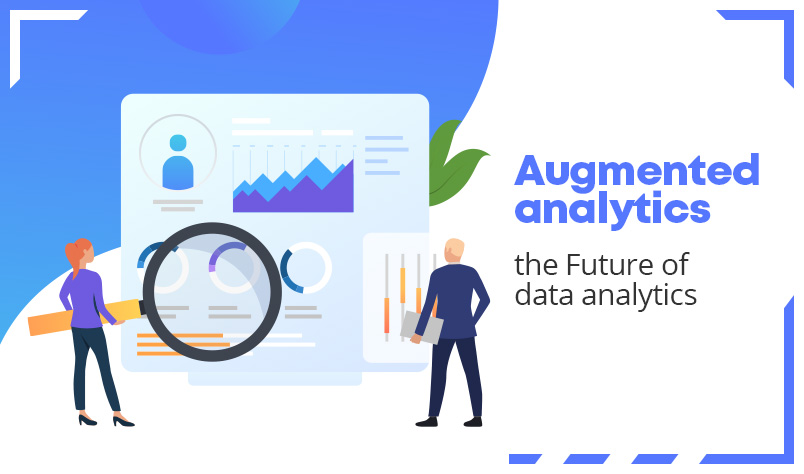The world revolves around data today. With consumers going online for making their day-to-day purchases, companies around the world are experiencing a surge in data that they acquire related to their customers, that makes it inevitable to make sense of it with the right professionals at work. Equipping the organizations with machine learning and artificial intelligence is a pre-requisite to nail amplified business growth.
Augmented analytics is powered by AI and machine learning to enhance human curiosity, making it easier for business users to prepare, analyze and visualize their data. Users gain insights faster by exploring their data using conversational language, while algorithms provide contextual for relevant insights. Artificial intelligence coupled with augmented systems of processing data are sure to lead to multitude of improvements in business campaigns, as they unravel market trends like none other. The global augmented analytics market size is anticipated to expand from USD 5.1 billion in 2020 to USD 25 billion by 2026, at a CAGR of 30.8% during the forecast period of 2022-27.
No doubt, AI is making strides in every industry possible. It augments human capabilities, that leverage the highest possible benefit for businesses across sectors. Data becoming the norm in the world business scenario. This revolution thus experienced in the way we go about doing business today, has experienced a pivotal change. Demand for certified data scientists has experienced a surge in the past decades as well. Data analytics is being increasingly leveraged by start-ups, SMEs, and large organizations to reduce costs, improve customer experience, optimize existing processes and achieve letter-targeted marketing. Data security has become another key factor why big businesses are keen on utilizing the perks of big data.
Role of Augmented Analytics in companies:
Augmented analytics is the future of business intelligence. As the word suggest, it assists in making better decisions that offer accurate business outcomes as projected. It enables businesses to stay ahead of the competition and stay pro-active while resolving consumers’ concerns in real-time. Being a dynamic industry, augmented analytics makes it easier for businesses to find insights in data and apply the findings into their business. Data and analytics leaders should not wait for this to become mainstream; they should take action now. Role of a learned data science professional and augmented analytics in business is critical as data is the fuel in creating better customer experiences and more efficient operations. Augmented analytics is surely the next step in analytics’ evolution.
Core steps for building Augmented analytics for business are:
- Data preparing
- Finding data patterns
- Operationalizing and sharing findings from data
| ADVANTAGES OF AA IN BUSINESS | DISADVANTAGES OF AA IN BUSINESS |
| Democratization of analytics- AA will democratize insights from analytics, including AI to all business roles. It allows professionals faster access to insights, in turn bringing in higher return on investment and greater innovation for businesses. | Adoption challenges- Ai has a lifecycle of its own, hence cannot fulfil the organisational expectation of quick and favourable results. Potentially damaging challenges includes the prevalent Black box image, lack of trust in recommendations and insights and job security. |
| Faster data preparation- Big data sources can be effectively evaluated using ML, while augmented analytics features in-depth automatic data evaluation | Inadequate skills- Investment planning on data analysis skill development is inevitable to gain insights to evaluate traditional or modern BI tools capabilities |
| Reduced time to insights- Deep insights and overall simplification of data analysis is possible | AI governance- Leading analytics experts need to outline rules to govern the use of analytic content and insights to ensure accuracy and validity. The adoption of AA will require existing organizational models to evolve and support a growing footprint of data scientists embedded in business units |
| Scalability and accuracy- Augmented analytics include tools that easily run-on cloud, which makes them scalable and easy to evaluate for accuracy. | |
| Reduced analytical bias- Makes it easy to handle complex data within and outside the organization to gather, prepare, interpret, analyze and provide smart business decisions. It reduces potential bias by performing automated analysis across large datasets of statistical importance |
Companies that have implemented augmented analytics has seen positive business outcomes such as an increase in decision making by 51%, an increase in efficiency by 50%, and a hike in effectiveness by 48%. Augmented analytics is the next wave of disruption in the data analytics market and must be adopted to build and sustain a competitive advantage. As is evident, the availability of required skill set for the industry is lacking severely, it makes it an urgent necessity to equip yourself with the most trusted internationally renowned data science certification in the industry from USDSI™. Also, the innovative functionalities of augmented analytics demonstrate a variety of applications across all sectors of the economy and promises to transform the digital landscape by streamlining business operations and increasing access to useful data.




